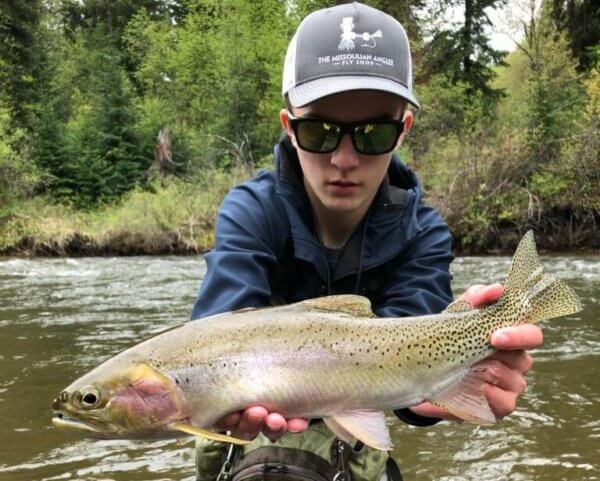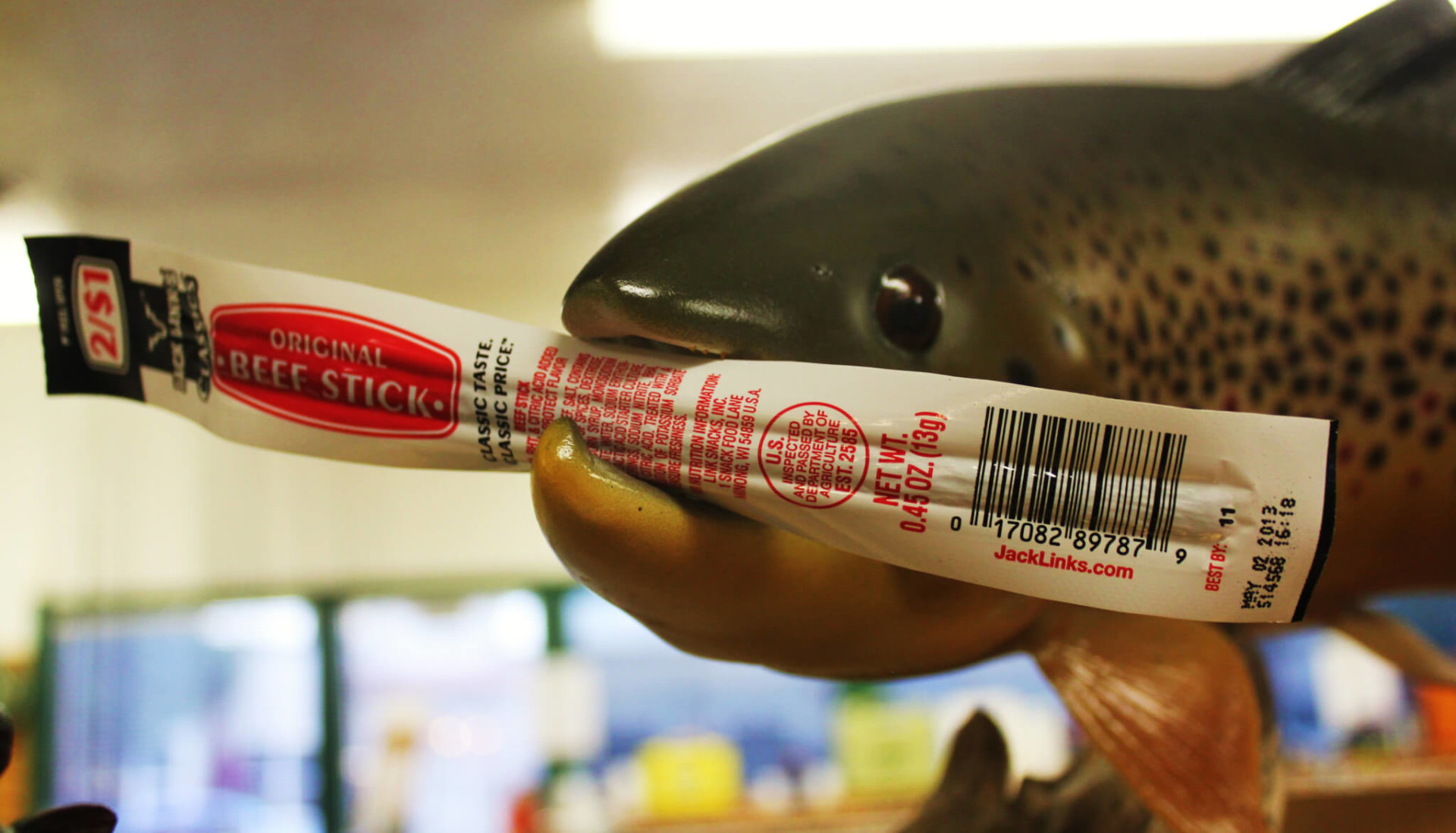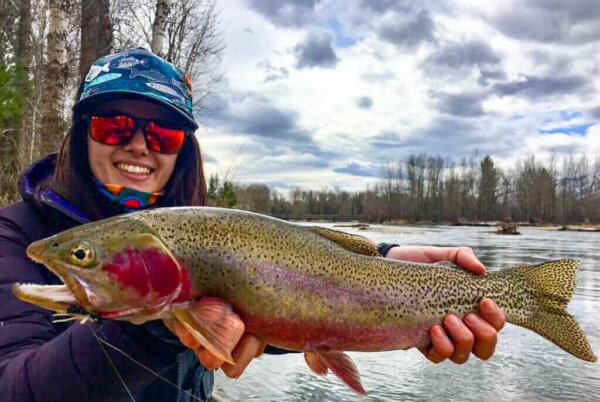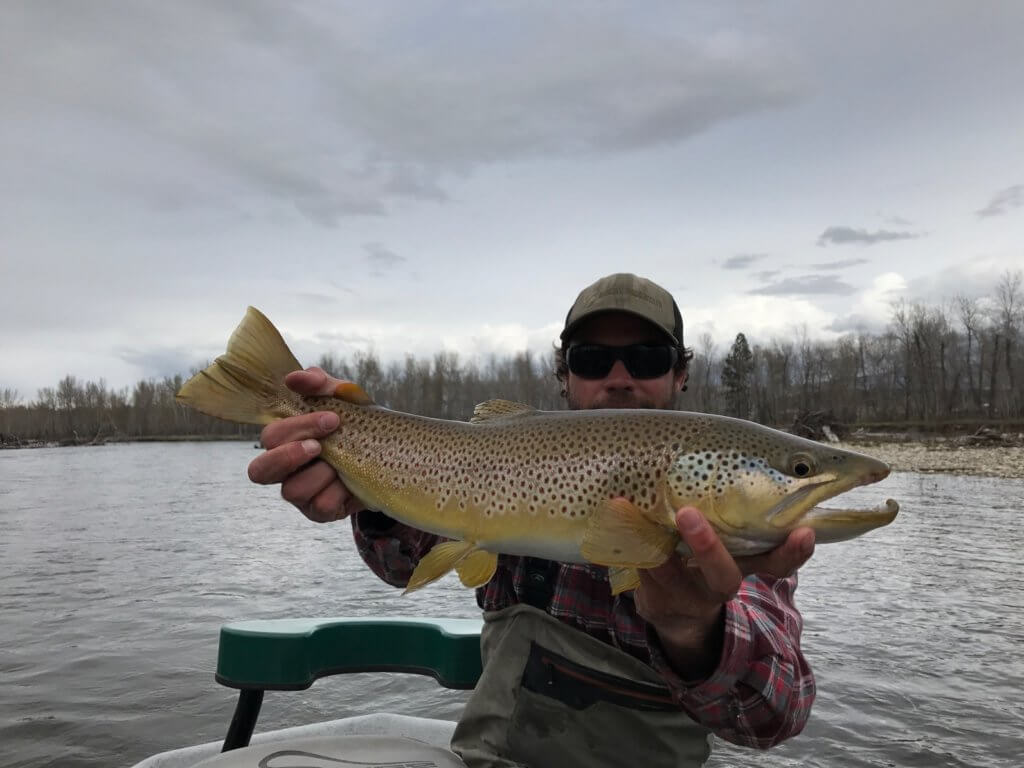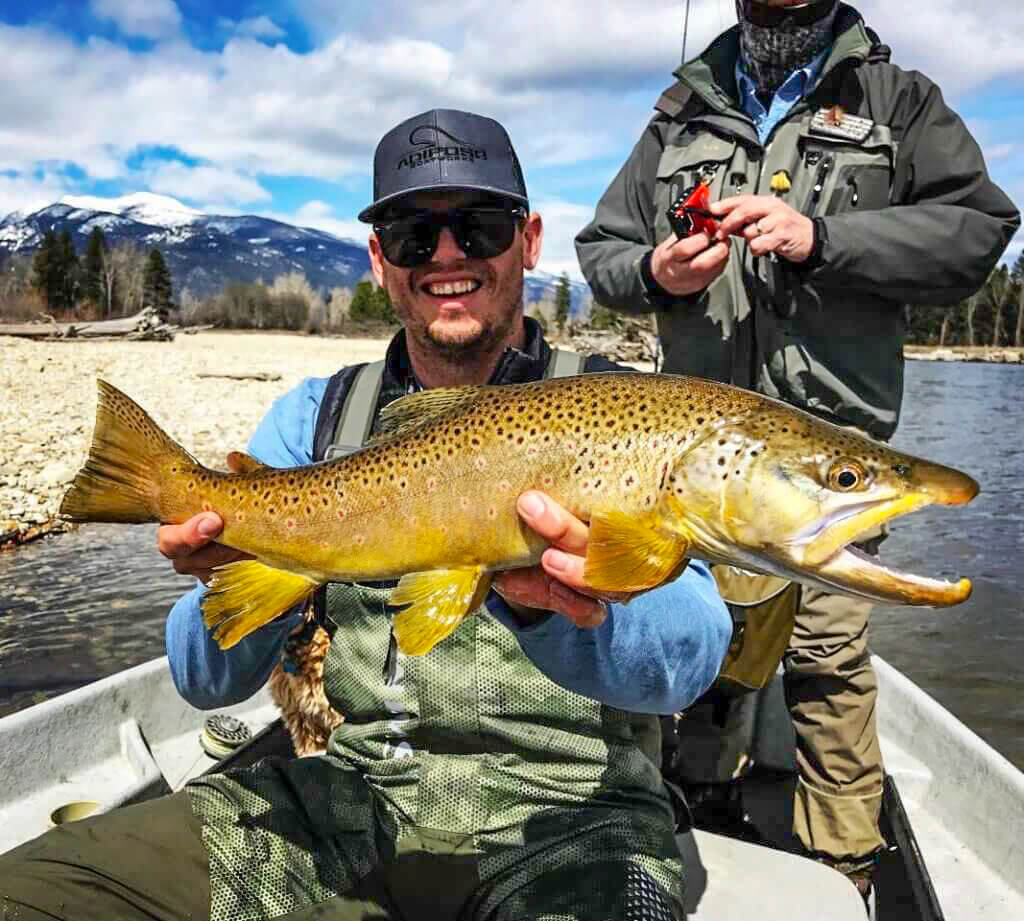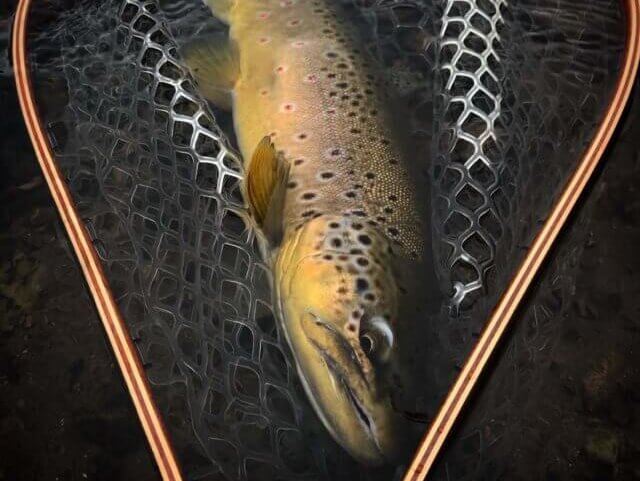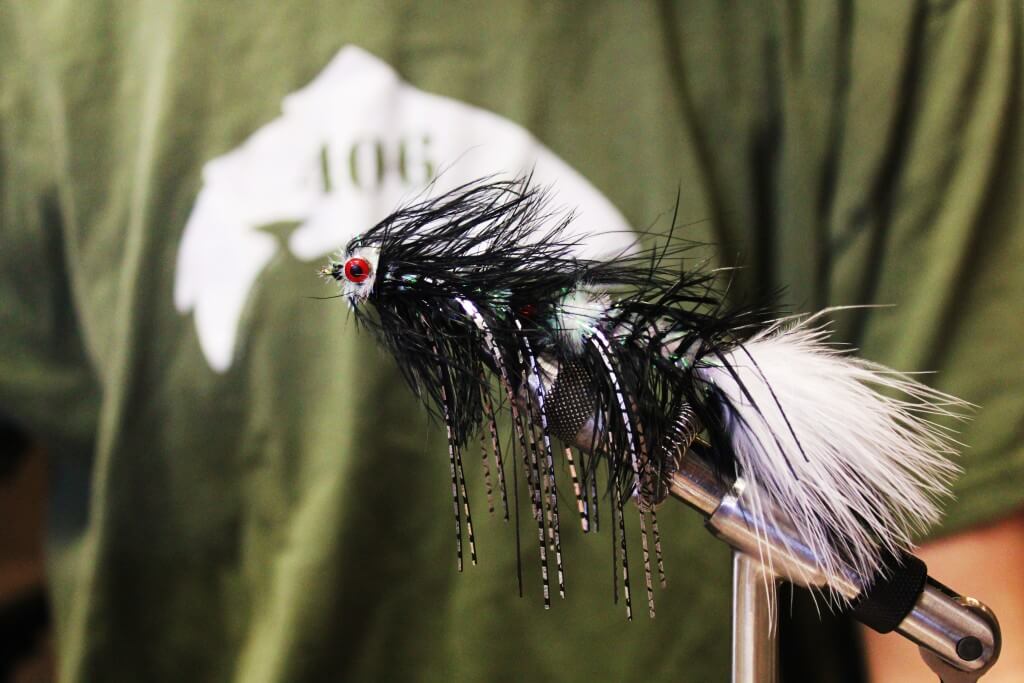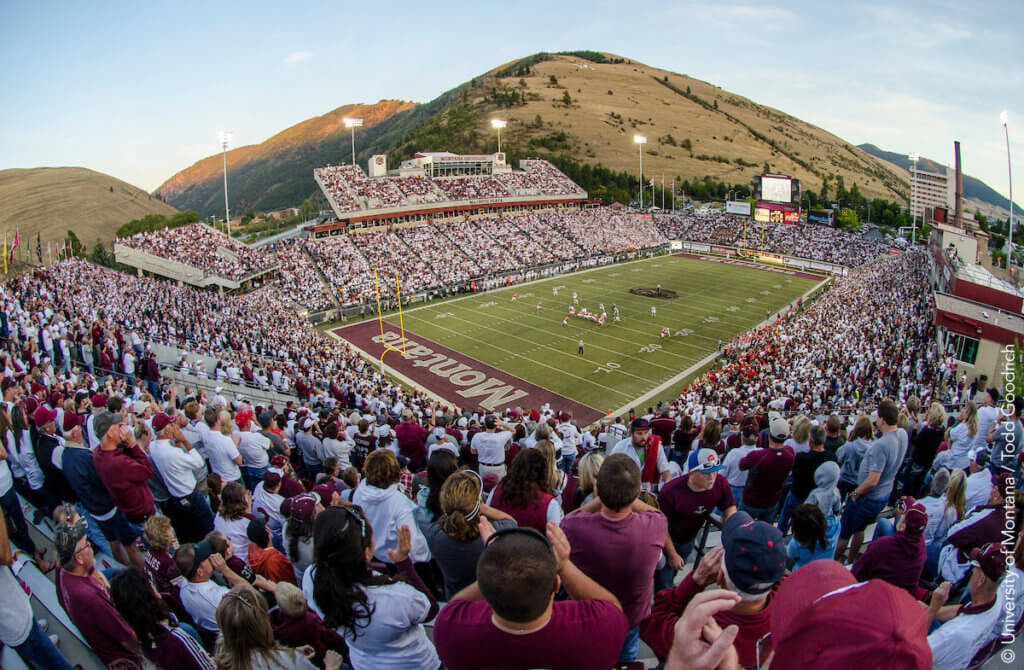Runoff is here, and it’s here to stay. The weather is warm, and the mountains still have snow. We’re going to have high water for the next five weeks. But that’s no reason you can’t fish. It’s not like the fish get to go on vacation when the water gets high. The trout are still in the Blackfoot River, Clark Fork River, Rock Creek and the Bitterroot River, doing the same things they always do. You just need to change your tactics.
Changing tactics means revisiting some basic principles. A trout can’t survive expending more calories than they take in. The high water has dramatically changed the nature of the river, and for a trout to survive, it must find shelter from the fast flowing water. While it might be obvious, the faster the water is moving, the more energy a trout must expend to maintain its lie. As you approach the river, you’re looking for places where the water is eddying, or very slow, as that’s where the trout must be to conserve calories. Use the foam on the surface to locate these places.
Another basic principle is 80% of the fish are found within 10 feet of the bank. That is so important during high water. The currents are always lesser near the banks, and since trout are looking to avoid the pressure of the water, they are hugging any shelter they can find. This is so much more prevalent near the shore, so much easier for the trout to locate. So you’re working the shore, looking for eddies and slower water.
When you’re standing at the river’s edge, it’s not always easy to see where the eddies are moving, or where the slower water will be. If you’re having difficulty defining the slower holding water, leave the edge of the river and go find a higher vantage point to view the river. It might be a high bank, a bridge or just walking up the bank a little way. As you get further from the river, the patterns of current become clearer. Once you’ve identified the slow water and places of trout shelter from above, then head to the river’s edge and look at those same places up close. It will soon become apparent what the best holding water looks like up close.
Another factor comes into play near the shore once you’ve identified the better holding lies. As the water moves more slowly next to shore, the mud, dirt and everything else the river is carrying will begin to precipitate out. This means near the shore, visibility will be better. We didn’t say good, only better. Because fish have to eat even in run-off, any advantage they can find they’ll take, so slow water next to the shore offers better sight as well as requiring less energy expenditure to stay there. Keep an eye on the weather. A couple of colder days will slow down snow melt, and the slower water will get more visibility as less debris is entering the water.
Finding access to the edge of the river can be challenging during high water. Gone are the days of long gravel bars and easy access. Right now the rivers are bank full, and running through the vegetation that is normally 25 feet from the bank. Run-off fishing is often about where can you get to the river and safely access casting to trout.
Safety is no accident in run-off. Not only is the water moving as fast as it will all year, which of course makes wading very dangerous, the high water is moving all the debris that’s gathered on the rivers edge since last June. That means logs, downed trees and other flotsam are floating down the river as well. So even if you’re in shin deep water, if a tree or log goes by and you don’t see it, it will sweep you into the river. Be smart, stay dry during run-off!
It also takes some planning to actually land a fish in run-off. You might find a place to access the river, but you also need to plan how you’re going to land a fish when you hook one. The first move is to use tippet about two sizes heavier than you usually would. Not only are you fighting the trout, you’re also fighting the current. A little extra pound test will help you bring the fish to the net, which is a critical piece of tackle for high water. It’s just too dangerous to get so close to the water so that you can grab the fish. Bring your net and use it. Before you cast, think about how you’re going to land the fish. Check for impediments, and make sure you have a clear, safe space to bring the fish to hand.
99% of run-off fishing is going to be subsurface. Sure, the stars might align, and you’ll run into a Mother’s Day Caddis hatch or an early Stonefly hatch, and even water where they’re rising. But don’t count on it. Be ready for nymphs and streamers. The most important part of your rig may be lead weight. You don’t have much room to cast, and your flies don’t have a long time to sink. Think about it this way. If your flies sink at a rate of one inch per linear foot of river covered, you will need to cast 60 feet upstream to get your fly 5 feet deep to a trout’s lie. But if your fly sinks at one foot per linear foot of river covered, you only need to cast 5 feet above that trout suspended 5 feet deep. It makes a huge difference, so have your lead weights and tungsten bead flies.
The Wire Worm, Pat’s Rubberlegs or any dark DoubleBead Stone are great flies to use during run-off. These are some of the fastest sinking flies we carry, and they will be very useful for getting deep quickly. But just because the water is big and fast, that doesn’t mean the fish only take big flies. Make sure to drop off a SR Quill Bullet, TH Duracell Jig or any other quick sinking smaller nymph off of the larger, heavier point fly. Most insects in the river are small- so don’t be fooled by the thought big water, big fly. Make sure to run smaller bug off the back of the big one. Don’t worry about using a heavier tippet and fouling up your drift. In fast water, the fish need to make a quick decision to eat or not. Add the difficulty of locating food in stained water, and you’ll find the fish to be a bit less fussy than mid-August. The heavier tippet also helps control the cast when you have an indicator, two flies and two split shot running along your leader.
When choosing a streamer, fly choice depends on the line you’re using. If you have a sink tip or sinking leader, a bulkier fly that may not sink as rapidly is very effective. The bulky fly helps the fish find it in off color water. If you’re using a floating line, a sparse fly with weight and maybe even a split shot or two will get the fly to where the trout are. (Dirty Hippie). Whatever streamer you choose, make sure you allow the cast to fully extend downstream. Work it as close to the shore as you can, for all the reasons that have been mentioned before. Fish where the fish are, so make sure your streamer spends as much time as close to the bank as possible.
It’s not easy to find the prime spots during run-off. The access points are few and far between, and it seems to change every day. A few cold days and nights, and the water starts to drop. Warm temps of course bring the water levels up. What’s good today may be gone in two days. While the access points may be few and far between, so are the anglers! If you’re looking for solitude, it can be easily found in the month of May. There’s not a lot of pressure on the Blackfoot River, Rock Creek, Bitterroot River and Clark Fork River. We can’t say you’ll find the best fly fishing in Montana of the season in May, but you will find some fish. Be safe, stay dry, and good luck when the conditions are difficult!

